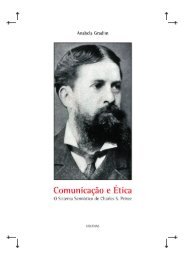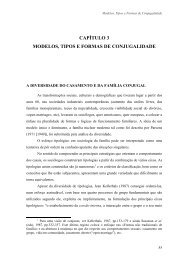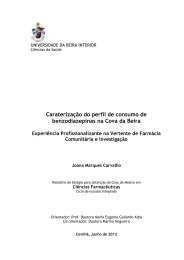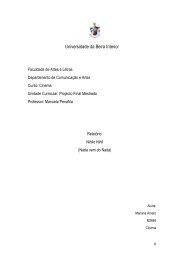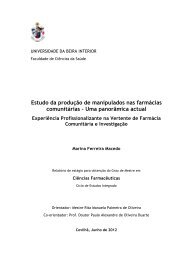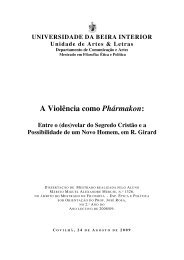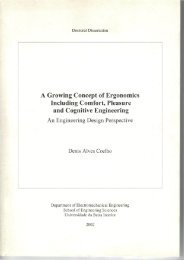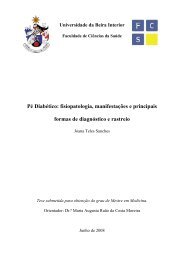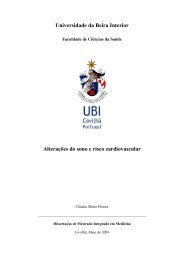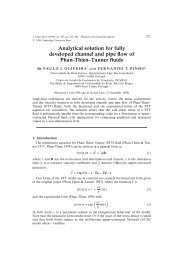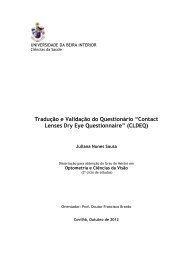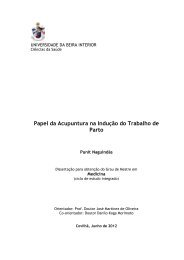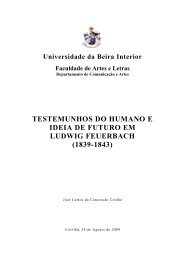Tese_Tânia Vieira.pdf - Ubi Thesis
Tese_Tânia Vieira.pdf - Ubi Thesis
Tese_Tânia Vieira.pdf - Ubi Thesis
Create successful ePaper yourself
Turn your PDF publications into a flip-book with our unique Google optimized e-Paper software.
Chapter III – Results and Discussion<br />
The MTS assay was also performed in order to quantify the cytotoxic effect of the<br />
different nanoparticles produced. The reagent MTS was reduced into a water-soluble brown<br />
formazan product. The absorbance of the formazan produced, is proportional to the number of<br />
cells whose mitochondrial metabolism is intact, after their exposure to nanoparticles (Mukherjee<br />
et al. 2011).<br />
For all the experiments the negative control (K - ), in which cells were only seeded with<br />
culture medium, presented a high percentage of viable cells. Conversely, the positive control<br />
(K + ), in which ethanol solution was added to the cells, showed no cellular viability. The MTS<br />
assay performed on the chitosan/dextran nanoparticles alone (1), in different concentrations,<br />
showed that cells’ viability was similar to the negative control, proving that this type of particles<br />
did not affect cell viability. These results are in agreement with a study performed by Anitha and<br />
collaborators, in which was shown that the chitosan/dextran nanoparticles had no toxicity for<br />
normal eukaryotic cells (Anitha et al. 2011). The toxic effects of AgNPs produced either by the<br />
reduction with C 6 H 8 O 6 (6) or NaBH 4 (7), were also evaluated. For these particles in low, MIC and<br />
high AgNO 3 concentrations (figure 15 A, B and C, respectively) the percentage of viable cells was<br />
similar to that of the K - , reinforcing the idea that these AgNO 3 concentrations in the<br />
nanoparticles did not have toxic effects for the cells. The same was also observed for the<br />
remaining nanoparticles, but only for low and MIC concentrations of AgNO 3 (figure 15 A and B,<br />
respectively). However, for the high AgNO 3 concentrations (figure 15 C), nanoparticles labeled as<br />
4 (Chitosan/dextran with AgNO 3 and C 6 H 8 O 6 ) and 5 (Chitosan/dextran with AgNO 3 and NaBH 4 )<br />
showed toxic effects for the cells. Furthermore, nanoparticles labeled as 2 (chitosan/dextran<br />
nanoparticles with AgNPs produced with NaBH 4 ) and 3 (chitosan/dextran nanoparticles with<br />
AgNPs produced with C 6 H 8 O 6 ) showed no toxic effects. Such features are explained by the fact<br />
that the AgNO 3 concentration used to reach the MIC value was lower in particles 2 and 3, than in<br />
the particles 4 and 5. Such results confirm that nanoparticles toxicity is dependent on AgNO 3<br />
concentration. This relation, of AgNO 3 concentration versus toxicity was already reported in two<br />
studies performed by Arora and collaborators, where they observed a decrease of the<br />
mitochondrial function of cells exposed to AgNPs (1.56–500 μg/mL) in a dose-dependent way<br />
(Arora et al. 2008; Arora et al. 2009). The analysis of the supernatants of the different<br />
nanoparticles (figure 15 D) showed that they were extremely toxic for cells, since the obtained<br />
values are quite similar to those of the K + , after two days of test. Therefore, it can be depicted<br />
that some toxicity could actually be due to the presence of contaminants in solution instead of<br />
the nanoparticles per se (Samberg et al. 2010). Based on this results, particles’ washing may<br />
represent a major issue in order to decrease some of the toxicity, that was previously reported<br />
has being caused by the nanoparticles.<br />
The MTS assay showed a significant difference between the K + and the K - cells exposed to<br />
the different nanoparticles after 24 and 48 h of incubation, for the low and MIC concentrations.<br />
These results confirmed that nanoparticles in low and MIC concentrations did not have any<br />
cytotoxic effect. For high concentrations, there was observed a cytotoxic effect for<br />
nanoparticles labeled as 4 and 5, after 48 h, since no significant difference was observed<br />
47



